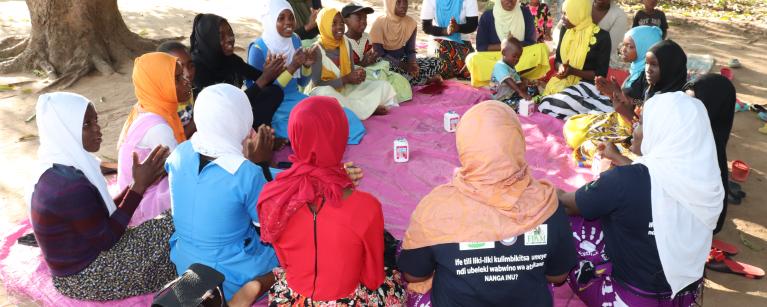It is a sunny Wednesday afternoon in Balaka District, in the Southern part of Malawi, and I am seated in awe as I watch Esnart Taipe lead a musical performance on Sexual Reproductive Health Rights (SRHR) for a youth gathering. A few minutes later, she sits down with them, and they discuss in detail how they can access SRHR services and why it is important for them.
In my country, Malawi, discussing SRHR with girls as young as 10 always attracts a judgmental “look”. Making SRHR information available to young girls is controversial. The colleagues I work with in Zambia and Mozambique share similar sentiments.
What is the price for making this topic a taboo?
In Malawi, for instance, the unmet need for contraceptives among adolescents remains high at 72 percent and this has had repercussions. About 21.7 percent of primary school dropouts are due to pregnancies, and in secondary school it is at 39.9%.
Most communities have reservations on this topic due to either cultural or religious beliefs. To see Esnart in a largely Muslim community talking to young girls about SRHR is not so common.
How did she convince her community, especially the parents of the girls I found her interacting with?
The 36-year-old Esnart says she started volunteering with young girls after noting the rising cases of teen pregnancies, sexually transmitted infections, and school dropouts in the area. She felt the trend could be reversed if young people had adequate information and easy access to sexual and reproductive health services.
“I felt I could be that guide and counsel them and started meeting them every week. I am always open with them and see the interests they have”, she said. “Some of the adults do not like what I do, but I do share with them the importance of sexual reproductive health education, and with time, some people are beginning to appreciate the importance of these discussions.
“Things are slowly changing now; even ten-year-olds approach me with questions. In the past, the majority were sent to their grandmothers for advice, which made them uncomfortable. Through our meetings, we encourage young people to be open with their parents and guardians on this, and now there is an improvement”.
17-year-old Fateema Aubrey is a member of Namanolo Youth Club. She says interactions with her peers and leaning about SRHR has impacted her positively.
“We learn about sexual reproductive health, culture, how to prevent HIV and AIDS and other sexually transmitted diseases. My parents understand the importance of the group, but some of my friends at school do not. They say we are learning about bad behaviors, but I don’t see it that way because for a very long time nobody in the club has fallen pregnant, which is not the case with those that do not come,” said Fateema.
In a world where information can be accessed at a click of a button because of the internet, it is essential that young people, who form about 70 percent of Southern Africa’s population, of which about 20 percent are aged 15-24 are fully aware of SRHR issues and have access to the services.
Evidence from Malawi, Mozambique and Zambia where Oxfam and partners with Funding from Global Affairs of Canada and Oxfam Canada are working with young people on SRH issues, shows a reduction in cases of early pregnancies, early marriages, and school dropouts.
In Mozambique’s Mocuba and Milange districts for instance, cases of school dropouts due to teen pregnancies or early marriages have reduced by over 50 percent because of the Her Future Her Choice Project which empowers young people on SRHR issues.
Unfortunately, aside from culture and religion, young people in Southern Africa face a myriad of challenges in accessing SRHR information and services due to challenges such as low internet access which perpetually affects their ability to make informed choices which in turn affects their education, future and general welfare.
The COVID-19 pandemic laid bare the challenges young people face to access internet services. For instance, many in – especially in the rural areas, could not attend online classes due to lack of internet access. In 2021, UNICEF found that only 25 percent of rural children and youth below 25 have access to the internet globally in which 19 percent and 5 percent represented the urban and rural child respectively in Eastern and Southern Africa.
Although countries are registering improvements in school dropout and early pregnancy rates, the numbers remain concerningly high. In Zambia, for instance, the 2020 Education Bulletin revealed that a total of 32,838 young girls dropped out of school due to pregnancies. Fortunately, 15,908 were readmitted, but the numbers are still not encouraging.
Southern African countries may be able to address this challenge by embracing digital spaces to promote young people’s access to SRHR information and services. It is therefore important that African leaders begin to invest and look into the role ICT may play in ensuring young people’s access to essential services, including SRHR.
This year’s Day of the African Child, commemorated under the theme “The rights of the child in the digital environment”, presents an opportunity for Southern African countries to reflect on how ICT can play a vital role and necessitate access to sexual reproductive health services and information for young people. Governments need to take deliberate measure that will encourage young people, particularly young girls to use digital spaces to empower themselves.
Happy Day of the African Child to every African child!
Rejoice Kankhande is the Her Future Her Choice Project Coordinator in Malawi
